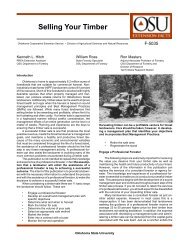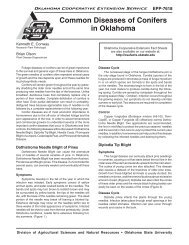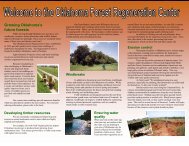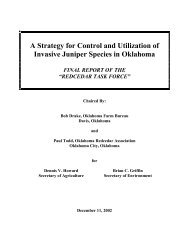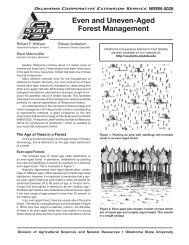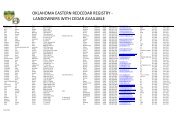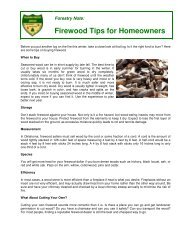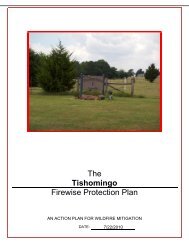Juglans nigra Black Walnut - Environmental Horticulture - University ...
Juglans nigra Black Walnut - Environmental Horticulture - University ...
Juglans nigra Black Walnut - Environmental Horticulture - University ...
Create successful ePaper yourself
Turn your PDF publications into a flip-book with our unique Google optimized e-Paper software.
Fact Sheet ST-320November 1993<strong>Juglans</strong> <strong>nigra</strong><strong>Black</strong> <strong>Walnut</strong> 1Edward F. Gilman and Dennis G. Watson 2INTRODUCTION<strong>Black</strong> <strong>Walnut</strong> grows with a rounded crown toabout 70 feet (can reach 100 to 150 feet in the woods)and spreads 60 to 80 feet when open grown (Fig. 1).Best growth occurs in a sunny open location and amoist rich soil, common along stream banks in itsnative habitat. The tree grows rapidly when young butslows down with age and develops with a number ofmassive branches well spaced along the trunk forminga very strong, durable tree. While valued as a lumbertree it may not make the best yard tree. The nuts areedible but are a nuisance to clean up and leaves oftenfall prematurely from some type of leaf disease.GENERAL INFORMATIONScientific name: <strong>Juglans</strong> <strong>nigra</strong>Pronunciation: JOO-glanz NYE-gruhCommon name(s): <strong>Black</strong> <strong>Walnut</strong>Family: JuglandaceaeUSDA hardiness zones: 5 through 9A (Fig. 2)Origin: native to North AmericaUses: specimen; no proven urban toleranceAvailability: somewhat available, may have to go outof the region to find the treeDESCRIPTIONHeight: 60 to 70 feetSpread: 50 to 70 feetCrown uniformity: irregular outline or silhouetteCrown shape: roundCrown density: moderateGrowth rate: mediumFigure 1. Middle-aged <strong>Black</strong> <strong>Walnut</strong>.Texture: coarseFoliageLeaf arrangement: alternate (Fig. 3)Leaf type: odd pinnately compoundLeaflet margin: serrateLeaflet shape: lanceolate; ovateLeaflet venation: pinnateLeaf type and persistence: deciduousLeaflet blade length: 2 to 4 inchesLeaf color: greenFall color: no fall color changeFall characteristic: not showy1. This document is adapted from Fact Sheet ST-320, a series of the <strong>Environmental</strong> <strong>Horticulture</strong> Department, Florida Cooperative Extension Service,Institute of Food and Agricultural Sciences, <strong>University</strong> of Florida. Publication date: November 1993.2. Edward F. Gilman, associate professor, <strong>Environmental</strong> <strong>Horticulture</strong> Department; Dennis G. Watson, associate professor, Agricultural EngineeringDepartment, Cooperative Extension Service, Institute of Food and Agricultural Sciences, <strong>University</strong> of Florida, Gainesville FL 32611.
<strong>Juglans</strong> <strong>nigra</strong> -- <strong>Black</strong> <strong>Walnut</strong> Page 2Figure 2. Shaded area represents potential planting range.FlowerFlower characteristics: inconspicuous and notshowy; spring floweringFruitFruit shape: roundFruit length: 1 to 3 inchesFruit covering: dry or hardFruit color: black; greenFruit characteristics: attracts squirrels and othermammals; fruit, twigs, or foliage cause significantlitter; showyTrunk and BranchesTrunk/bark/branches: grow mostly upright and willnot droop; not particularly showy; should be grownwith a single leader; no thornsPruning requirement: needs little pruning to developa strong structureBreakage: resistantCurrent year twig color: brown; grayCurrent year twig thickness: thickWood specific gravity: 0.55CultureLight requirement: tree grows in full sunSoil tolerances: clay; loam; sand; acidic; alkaline;extended flooding; well-drainedDrought tolerance: highAerosol salt tolerance: highSoil salt tolerance: moderateOtherRoots: surface roots can lift sidewalks or interferewith mowingWinter interest: tree has winter interest due tounusual form, nice persistent fruits, showy wintertrunk, or winter flowersOutstanding tree: not particularly outstandingInvasive potential: little, if any, potential at this timeOzone sensitivity: tolerantVerticillium wilt susceptibility: not known to besusceptiblePest resistance: very sensitive to one or more pestsor diseases which can affect tree health or aesthetics






